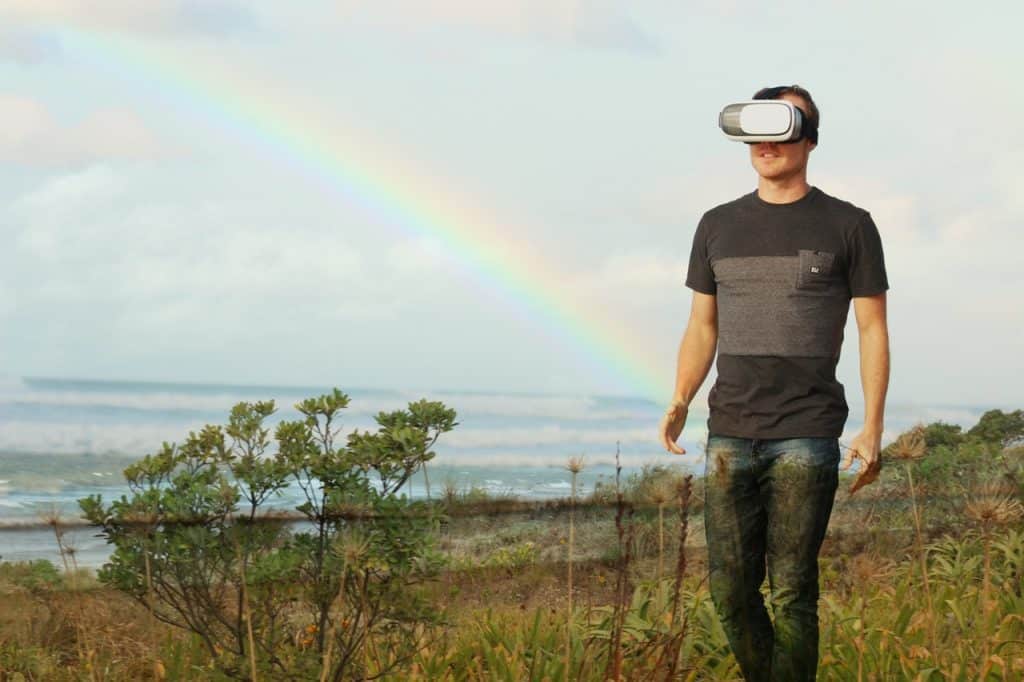Virtual reality (VR) has been making many strides in both game development and content marketing recently.
The sports and entertainment industries in particular are currently utilizing marketing with virtual reality using branded content to sell frontline experiences at matches and concerts.
Offering the customer a sample of what they can experience has been effective for selling VIP packages and the ability to see a game from home and literally get into it.
However, the real estate industry is also stepping up VR and marketing by making use of VR experiences to revolutionize how people look for housing.
The Landscape of Real Estate and Virtual House Hunt
Apartment-hunting can be a thorn in people’s sides for many reasons, especially in cities with tight housing markets like New York and San Francisco where the options are endless but someone can snag the apartment before you even show up for the tour.
A rent.com survey says 56% of apartment hunts take longer than three weeks, which can be a serious problem if a prospective tenant has an emergency such as a job change or household expansion necessitating new housing immediately.
The same survey also said that 29% of apartment-hunters looked at more than 20 apartments online before moving into one.
Apps like Realtour360° are using 360 cameras and virtual reality in order to give prospective tenants and buyers a thorough and interactive apartment-hunting experience.
Photos Are No Longer Enough
Photos can only show so much whether they are professionally staged by a real estate agent or quickly taken with a phone to find someone to sublet your apartment as fast as possible.
Realtour360° offers solutions for individuals, brokers, and real estate agencies so that taking 360 shots of your property is done in a snap and people viewing it can see more than what a photo would show them.
This is especially helpful for large and small properties alike, in that photos can be deceiving and the exploration aspect using both the 360 images and VR can make what’s often a very stressful process into something fun and engaging.
The app lets you add hotspots on the screen so that if you’d like to include static images of features such as appliances, crown molding, upgrades, and more the house-hunter feels welcome and like they’re on an adventure.
Increased Insights & Interaction
“There are so many applications for exploration and story-based games and campaigns with Realtour360°,” founder Jim Prucey states.
“It’s very easy and intuitive to touch items and interact with them, then use a VR headset so you feel like you’re right there.”
Marketing with virtual reality and further innovations in the field will make house and apartment hunting much easier for both listing agents and buyers/tenants.
By eliminating the need to arrange several visits, people searching for a home can save a great deal of time looking at multiple properties before committing to seeing some of them in person.
This also saves the listing agent time, and listings will also spend less time sitting on the market as a result of getting exposed to more serious buyers or tenants.
Benefits of Virtual Reality for Real Estate
When it comes to virtual reality in real estate marketing, the benefits are impressive. Here are a few of those benefits to show you why you need to consider adding VR for real estate to boost your efforts.
VR allows you to personalize the experience
Personalizing the shopping experience is a winning approach to gaining the respect and attention of customers today. Expanding that personalization to the search for suitable and desirable real estate is now possible and can truly make a difference.
Virtual reality allows customization of the home search experience, letting the customer personalize specific details of what they see (e.g., changing the colors of walls). Doing so allows them to become more engaged in the process and boosts their desire to make a quicker decision.
VR saves both time and expense
While creating 3D virtual tours can use up a good portion of your marketing budget, the overall results can be rewarding.
You save both time and expense by making fewer trips to different properties and limiting glossy print-outs of various materials to hand out.
Plus, the potential buyer can use VR to narrow down the properties they wish to visit in person, saving them both time and money.
VR allows for a more immersive experience
By incorporating VR into your real estate marketing, you can give potential buyers or tenants a more immersive experience.
A virtual reality real estate tour, which allows potential buyers to see the layout and design of a home, includes 360-degree views of both the interior and exterior.
As such, they can virtually interact with different homes, which will help them narrow down their choices more quickly.
VR expands the ability to reach more customers
With VR, you can market your properties to a wider audience located near or far at any given time. No travel is required for buyers or future tenants to “tour” homes in your area.
Essentially, that is to say, you can generate more views of properties than would be possible if required to do in-person showings to one customer at a time.
As an even bigger bonus, more than one potential client can view the properties at the same time, increasing the chances of a sell or lease agreement.
How to Use VR in Real Estate
Four of the most beneficial ways to use VR in real estate marketing today include creating 3D tours, utilizing virtual home staging, customizing for V-commerce, and offering new construction visualizations.
Create a 3D tour of each property
Creating a 3D tour of a property provides the potential buyer or tenant with a closer view, making them feel as if they are walking through the home themselves.
These tours can be guided so that you take them through 360-degree views, or they can be interactive, allowing the viewer to choose where to go next and what to see.
The goal of these virtual tours is to showcase the physical and virtual layout of real estate. Use them for houses, short-term or long-term rentals, and even Airbnb listings.
Once you learn how to create a VR tour for real estate marketing and discover how well it works for drawing in customers, you’ll be hooked.
Utilize virtual home staging
Staging a home can be expensive, and you may or may not gain from your efforts, as potential buyers and tenants have different preferences.
An empty home, however, is often less inviting to potential buyers, and many cannot visualize its potential. For this, virtual home staging will be beneficial.
With the use of editing software, you can virtually stage a home to capture the attention of your particular customers and help them see what could be. Allow them to discover what a particular room might look like with different color schemes, interior designs, or furniture positioning.
Customize for V-Commerce
Customize your virtual tour to appeal to your particular customer, focusing on particular assets that you know are important to them, such as interior design or lighting.
You can also add features that allow them to choose different furniture, change layouts, switch colors, and more, such as introducing them to products they may want to purchase to include in their new home.
This approach, called customizing for V-commerce, can bring you success in more ways than one.
Provide New Construction Visualizations
Marketing real estate that has yet to be built is a challenge that can be met with the help of virtual reality. Many buyers and tenants have a difficult time imagining how the interior or exterior will look and will discount new construction options.
For real estate still in the planning stages, you can use immersive technologies to showcase how the exterior and interior will look, selling it before even the foundation is poured.
In other words, you help those you are marketing to visualize what is to come and help them determine what they want.
This VR approach can benefit quicker decision-making, such as which variations or upgrades are desired with the original home design.
Interactive Content Is the Future of Real Estate
Creating an immersive experience for potential customers is becoming more and more common today, so much so that people are expecting it to help them make quicker decisions. To create this immersive experience, you will need to start with interactive content that meets the wants and needs of your target audience.
Interactive content is increasingly shaping the approach to successful real estate marketing today, creating an experience that attracts more viewers and increases sales.
It is also easier than ever for anyone to take this approach with the use of interactive technologies and content creators. You can begin by working with professional content writers like those found with WriterAccess and utilizing Ion, a comprehensive online platform that allows you to easily create interactive content experiences.
All you have to do to get started is sign up for the WriterAccess free 14-day trial, become familiar with the platform and writers, and determine how best to create the interactive content you want by becoming familiar with the user-friendly Ion platform.
Start creating interactive content with Ion and increase your marketing results!
Start creating interactive content with Ion and increase your marketing results!







